

Have you ever wondered what cowboys did before they had the Weather Channel? After all, a herder's life could depend on the approaching weather conditions. Over the centuries, farmers and others whose lives and livelihoods depended on the weather developed a rich treasury of weatherlore. Some of it wasn't reliable, but a lot was based on principles that still guide meteorologists today.
Even today, it's a good idea to have some understanding of the old-time weather lore. When you're out on the trail, those old weather observations can warn you about changes in the weather and possibly even save your life. It's a good idea to carry a small weather radio, but even that won't help you much if the batteries go dead or your horse accidentally steps on it. With that in mind, here's a bunch of weather tips for you to tuck in the back of your head.
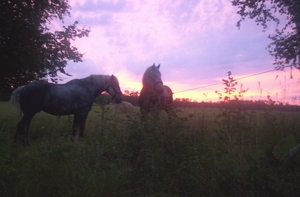 Remember that these indicators of weather patterns are fairly short range and may not hold for any specific location. On a recent trail ride, for instance, I woke to see the classic "red sky at morning" -- which generally means rain. I stayed dry all day, however, while folks a few miles away from me got drenched! (Also bear in mind that these tips are for the Northern Hemisphere, where weather fronts move from west to east and storms rotate in a counter-clockwise direction. South of the equator, you may have to reverse some of these sayings.)
Remember that these indicators of weather patterns are fairly short range and may not hold for any specific location. On a recent trail ride, for instance, I woke to see the classic "red sky at morning" -- which generally means rain. I stayed dry all day, however, while folks a few miles away from me got drenched! (Also bear in mind that these tips are for the Northern Hemisphere, where weather fronts move from west to east and storms rotate in a counter-clockwise direction. South of the equator, you may have to reverse some of these sayings.)
| A special thanks to meteorologists Justin Liles, meteorologist at WDIO/WIRT TV in Duluth, Minnesota, and Jessie Watmore, for looking over these bits of weather folklore. They graciously steered me around some potentially misleading statements and also provided some of the technical background. (You can catch Justin's weather forcasts at www.wdio.com.) |
My great grandfather was captain of a dredge on Chesapeake Bay and, like all mariners, needed "a sharp weather eye." When he passed away, relatives going through the contents of his desk found a copy of Thomas Tusser's "Five Hundred Points of Husbandry," printed in London, England, in 1744. Here's just one of the weather tips in rhyme it offered:
 A similar old saying goes like this:
A similar old saying goes like this:
"When the rooster goes crowing to bed,
he will rise with a watery head."
As the sky darkens from an approaching storm front, chickens and other birds begin to hunker down... roosting, as if for the night. A rooster will crow as an alert message to the rest of the flock -- to awaken in the morning, or to head for shelter when danger approaches. The calls of many birds, including crows and geese, have been known to be more frequent with falling pressure.
This may also be related to the fact that thinner low-pressure air makes flying more difficult for birds, so they tend to roost before a storm. High pressure air, on the other hand brings good weather and allows birds to fly higher, where they can take advantage of more favorable winds. Thus, the old proverb: "Birds fly higher in fair weather than foul." This is why duck hunters dislike blue skies.
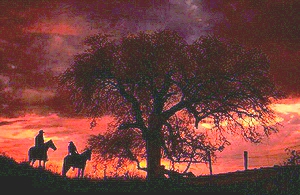 Here's Cowboy Bob's variation of a famous old weather saying:
Here's Cowboy Bob's variation of a famous old weather saying:
"Red sky at night, herder's delight.
Red sky at morning, rider take
warning."
This concept was old back when Jesus referred to it: The Pharisees and Sadducees came to Jesus and tested him by asking him to show them a sign from heaven. He replied, "When evening comes, you say, 'It will be fair weather, for the sky is red,' and in the morning, 'Today it will be stormy, for the sky is red and overcast.' You know how to interpret the appearance of the sky, but you cannot interpret the signs of the times. -- Matthew 16:1-3 (New International Version)
A night time thunder storm was a cowpoke's worst fear on a trail drive. The resulting stampede could cost the lives of many cattle at best, and anyone who happened to be in front of the herd or who stumbled on an unseen obstacle in the dark was certain to be badly injured -- or even killed. If an overcast sky turned bright red at sundown, it indicated that the setting sun was shining through a clear sky to the west -- much to the night herder's delight. On the other hand, if the rising sun shone through the dust of clear air and lit up the underside of a cloudy sky, a rider knew that overcast conditions were moving in and he'd best keep his slicker handy.
The same principle generally holds true for rainbows. A rainbow at sunrise indicates rain moving in from the west. A rainbow late in the day is a sign that the precipitation has moved to the east of you and the setting sun is shining through clear air to the west.
"Wind backing, weather's lacking;
Wind veering means clearing."
Wind direction changing in a counter-clockwise direction ("backing") indicates the approach of a low-pressure storm system. A fair weather high pressure front causes the wind direction to shift clockwise ("veering") as it moves in.
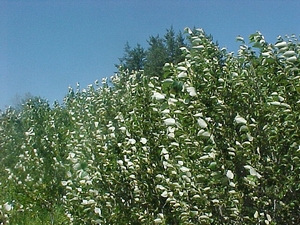 Meteorologist/horse lover Jessie Watmore sent this comment to me:
Meteorologist/horse lover Jessie Watmore sent this comment to me:
"Always watch for backing or veering winds. Backing winds (winds
shifting in a counter-clockwise direction, such as southerly winds
shifting southeast) generally indicate that bad weather is on its way.
On the other hand, veering winds (winds shifting in a clockwise
direction, such as southwesterly winds shifting west) generally
indicate the ending of bad weather and good weather is on its way. This
has to do with the way that the air rotates with approaching low
pressure systems and retreating low pressure systems."
Closely related to the wind direction is this old saying:
"Leaves turning silver a change will
deliver."
In calm conditions or with the wind coming from its normal,
fair-weather direction, the tops of leaves get the most sunlight and
turn a darker green. When the wind shifts (a frequent indicator of
stormy weather approaching) the leaves get turned the "wrong" way and
show their lighter "silver" undersides. Even if rain doesn't arrive in
your neck of the woods, the silver leaves at least mean that the wind
has changed direction and/or increased speed.
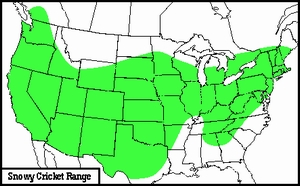 "You can use
a cricket to tell the temperature."
"You can use
a cricket to tell the temperature."
Across most of the U.S. -- except for the northern plains and far
southeast -- in warm weather you can use a cricket to tell the
temperature. The snowy tree cricket is sometimes called the
“thermometer cricket” because its chirps are easy to count and the rate
of chirping correlates well with the temperature where the cricket is.
Count the chirps in 14 seconds, then add 40 to find the temperature
(where the cricket sits) within a degree or two. Please note that this
only works reliably with the snowy tree cricket.
"Many springs that have gone dry will have a good flow of water before
rain."
High pressure air may reduce the flow of water from a spring,
while the reduced resistance of a low pressure system will allow the
water to flow more freely.
"When swamps smell, sit home a spell."
Low pressure preceding a storm allows more odors to escape from swamps,
ditches, sewers, etc. If the air suddenly smells foul, it often means
that the weather will turn foul as well. A similar saying is: "When
ditches and ponds offend the nose, Look for rain and stormy blows."
Likewise, the low pressure before a storm causes your body to release
more insect-attracting odors; thus: "Flies
bite before a flight." When
insects become increasingly troublesome it may signal the approach of
bad weather.
Face a low pressure storm's wind and point to your right to locate the eye of the storm. Again, this principle applies in the Northern Hemisphere, where storm winds flow in a counter-clockwise direction.
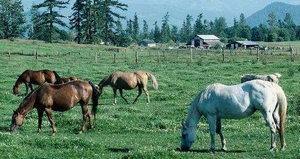 "Tails
pointing west, weather's the best.
"Tails
pointing west, weather's the best.
Tails pointing east, weather's the
least."
Horses and cattle usually graze facing downwind so they can smell any
predator upwind of them and keep an eye open for anything approaching
from downwind. A strong east wind indicates the approach of wet
weather. A west wind, on the other hand, means fair weather.
"When ropes hold tight it's going
to rain;
When weather's fair, they go
slack again."
Humidity generally rises before a storm, causing the fibers in rope to
swell and knots to get tighter before a rain. Obviously, this only
applies to natural fibers -- not nylon ropes!
"Smoke curls down when a storm is coming."
When smoke from your campfire hangs close to the ground, you'd best
keep your rain gear handy.
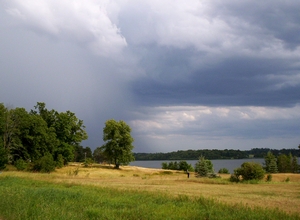 "A sunny shower won't last an hour."
"A sunny shower won't last an hour."
Scattered clouds with blue skies in between indicate that a storm front is breaking up and the rain will end soon. However, Justin cautions, in the summer a sunny shower may also indicate what's to come. If a sunny shower is beginning to develop, large thunderstorms may follow. This may indicate the atmosphere is trying to stable itself out. Convective storms or storms caused by intense surface heating may produce severe weather. When clouds blow up, a person may see a sunny shower first and may be on the verge of something much larger. Thunderstorms that develop along a dry line are a good example of this. A dry line is where very moist unstable air meets cooler, drier air. Convective active outbreaks can occur with adequate heating from the sun.
"Rain long foretold, it will hold.
Short forecast, soon past"
Warm front storms begin high and gradually come lower to the ground as the front moves through, giving plenty of warning of the approaching rain. A cold front, however, moves like a bubble rolling low over the ground, with a blunt front and no tell-tale leading edge. (Or perhaps a limp, partially-filled water balloon rolling over the ground would be a better illustration.) Although cold front rain generally falls harder, it is also of shorter duration.
Justin adds this background: A warm front is defined as the leading edge of a mass of warm air. Warm fronts move more slowly than cold fronts, which usually follows due to the fact that cold air is more dense, and harder to remove from the earth's surface. If the warm air mass is stable, clouds ahead of the warm front are mostly stratiform and rainfall gradually increases as the front approaches. At the front itself, the clouds may reach the surface as fog.... Clearing and warming is usually rapid after the front passes. If the warm air mass is unstable, thunderstorms may be embedded among the stratiform clouds ahead of the front, and after the front passes, thundershowers may continue.
A cold front is defined as the leading edge of a cooler and drier mass of air. The air with greater density wedges under the less dense warmer air, lifting it, which can cause the formation of a narrow line of showers and thunderstorms when enough moisture is present. The key word here is "wedge." A cold front acts like a snow plow would in the winter. The plow (wedge) lifts the snow (moisture) up rapidly. This upward motion causes lowered pressure along the cold front.
"When the night has a fever, it cries in the morning."
A temperature rise between 9:00 p.m. and midnight indicates the arrival
of a rain-producing warm front. Justin comments, "This goes back to the definition of a warm front and how warm, moist air, cooled enough during the overnight hours, can squeeze out fog. This happens a lot here in the Northland. However, if the winds are strong, fog cannot develop. The wind mixes up the atmosphere."
"Moonlit nights have the heaviest frosts."
A clear sky allows more heat to escape from the earth's surface,
causing colder temperatures.
"When bees stay close to the hive,
rain is near by."
I don't know how they know, but those little critters have an uncanny sense of approaching storms.
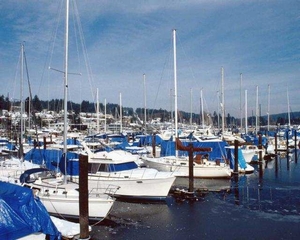 Here are two closely related bits of weatherlore:
Here are two closely related bits of weatherlore:
"Mares' tails and mackerel scales
Make tall ships take down their sails."
"When mares' tails fly, wind and rain are nigh.
When they point down, calm and dry are found."
Jessie Watmore comments: "This proverb [the first] can actually be quite accurate. Mares' tails are a type of cirrus cloud, which is the form of cloud that exists highest in the atmosphere. As a general rule of thumb, the lower the clouds are, the more likely it is that rain and storms could arrive. High cirrus
clouds by themselves are generally fair weather indicators. However, when they are followed by the lower 'mackerel scale' clouds, they could indicate bad weather. 'Mackerel scales' are clouds known as cirrocumulus clouds. They exist lower in the atmosphere than cirrus clouds, and are
formed by small convective currents and instability in the atmosphere. In the midlatitudes, cirrus clouds followed by cirrocumulus clouds (mares' tails followed by mackerel scales) are usually the first clouds to be seen during an extratropical cyclone or passing of a cold front, which brings rain and storms. However, it is also possible that even when seeing these bad weather indicators the bad weather might pass a distance away from the observer.
"As for the other proverb, 'When mares' tails fly, wind and rain are nigh,' here's a summary: Mares' tails are a form of cirrus clouds, which are high clouds composed of ice crystals. They form when an updraft is present, which raises water vapor in the air to the point of condensation. When this happens, the water vapor condenses to water droplets, which, in turn, freeze into ice crystals. These are seen as cirrus clouds in the sky. When the updraft present in the atmosphere dissipates, or the ice crystals become too heavy, the crystals begin to fall – which can be seen as the tail of the mares' tail cloud. However, I haven't been able to find any scientific evidence one way or the other about that proverb. Just thinking out loud, I could see how mares' tail clouds that are pointing down indicate the dissipation of an updraft. An updraft is necessary for the development of bad weather. If the updraft has dissipated, then this could indicate that better weather is
on its way because the updraft is no longer a threat. However, if a particularly strong updraft was present, it might be the reason behind an upward-pointing mares' tail cloud. If the updraft were strong enough,
it could carry the ice crystals even higher in the atmosphere which could result in an upward-pointing mares' tail cloud. A strong updraft would be a good indicator that bad weather is more likely to develop. But these
are my own conclusions, and I'm not sure if they would pan out to be true in every situation."
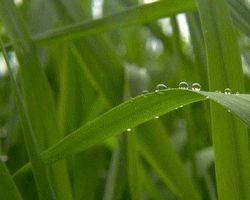 "Morning dry, rain is nigh.
"Morning dry, rain is nigh.
Morning wet, no rain yet."
A heavy dew in the morning indicates fair weather.
"Sound traveling far and wide
Stormy weather doth betide."
Distant sounds, such as the rumble of a train or bird calls, often
sound louder or have a somewhat hollow sound before the arrival of a
warm front storm. The higher the humidity, the better sound travels.
The difference can be subtle and may not be noticed by folks not used
to outdoor sounds.
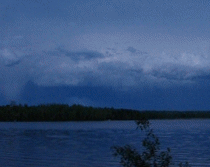 How far away is that lightning?
How far away is that lightning?
To estimate your distance in miles from a lightning strike, count the
seconds between the flash and the thunder and divide that number by 5.
What should I do if I'm caught in a thunder storm while out riding my
horse?
Don't take shelter under a tree.
Try to get into a steel building that will act as a "Faraday cage."
Away from home, a vehicle or horse trailer may offer the best
protection. In general, if you surround people or animals with a
metallic roof, metallic framing on the sides, and either have a
metallic connection (such as a safety chain) or no connection to ground
(rubber tires), the critters inside are relatively safe. The lightning
should stay on the exterior surface of the metallic structure and jump
off to ground.
Find a low spot that is not likely to flood or be hit by a flash
flood.
If your hair stands on end or your skin tingles, lightning may be about to strike you. Drop to the ground immediately!
What should I do if a tornado is approaching?
Jessie Watmore adds the following good advice: "It is important to know what the weather might do when you are out riding on the trail. So, even besides using your own intuition and watching the skies, it would also be a good idea to invest in a portable weather radio that alerts you if a severe weather watch or warning is issued in your area. Inexpensive models can be found at:www.weatherradiostore.com and looking under 'Portable Weather Radios.'
"Another bit of advice that I would give people would be to have a
barometer and anemometer installed at your house or barn. Knowing
whether the barometric pressure has risen or fallen is a good indicator
of whether good or bad weather is on its way. In general, falling
pressure
indicates incoming foul weather, while rising pressure indicates
incoming nice weather. You can get more precise and accurate by the
addition of an anemometer, which measures wind speed and direction, or
even just a wind vane, which just shows the wind direction. By using a
chart, taken from the National Weather Service and reproduced on
USAToday.com, you could generally predict the coming weather conditions
(www.usatoday.com/weather/wfbarrow.htm).
This will give you an indication of what weather to expect out on the
trail, or whether you should go at all! Also, always check the weather
on the NWS website (www.nws.noaa.gov) or your local news
report before going."
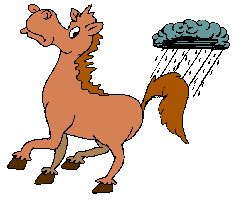 Of course, if you don't want to rely on all that fancy equipment,
you can just use your horse's tail to tell the weather!
Of course, if you don't want to rely on all that fancy equipment,
you can just use your horse's tail to tell the weather!
God's voice thunders in marvelous ways; he does great things beyond our
understanding.
He says to the snow, 'Fall on the earth,' and to the rain shower, 'Be a
mighty downpour.'
So that all men he has made may know his work, he stops every man from
his labor.
The animals take cover; they remain in their dens.
The tempest comes out from its chamber, the cold from the driving winds.
The breath of God produces ice, and the broad waters become frozen.
He loads the clouds with moisture; he scatters his lightning through
them.
At his direction they swirl around over the face of the whole earth to
do whatever he commands them.
-- Job 37:5-12
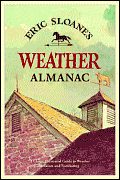
If you're interested in learning more about weather folklore, I'd
recommend buying a copy of Eric
Sloane's Weather Almanac. Before artist Eric Sloane became famous
for his paintings and books, he was one of the top weather experts in
the U. S. and wrote several books on the subject for the U. S. Navy.
![]() Return to Cowboy Bob's Home Page
Return to Cowboy Bob's Home Page
COPYRIGHT © 2007-19 BOB LEMEN, GRAND RAPIDS, MINNESOTA.
ALL RIGHTS RESERVED.
The contents of this document are not for reproduction.